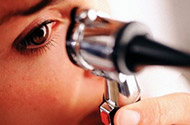Glaucoma
At first sight a human eye seems to be a simple organ, but is has a very complicated structure. The structures of the eye include a lens, muscles, envelopes, nerves, etc. All these formations require constant nutrition.
Nature provides the flow of fluid to the eye, thus providing different nutrients: proteins, lipids, carbohydrates, and microelements. The fluid washes the eye structures and flows along special canaliculi. Unfortunately, with time the drainage system of the eye can be completely blocked by waste products, which decreases considerably the velocity and volume of the fluid, flowing out from the eye. There is gradual increase in the intraocular pressure, pressing the eye from the inside, the optic nerve, in particular.
It is noteworthy that in the act of eyesight the eyes are a camera, while human brain is a computer, analyzing the image, received from the eyes. Normal functioning of the eyes and maintenance of eyesight require keeping the intraocular pressure in the range of specific indices constantly, otherwise there may be excessive pressure on the optic nerve inside the eye. Excessive intraocular pressure leads to gradual necrosis of cells of the optic nerve, unobservable for the patient, which results in cutting off the image and human brain does not see the entire picture of the world.
Normal intraocular pressure is constant (16–25 mm Hg). The circulation of blood inside the sick eye gets broken, the fluid accumulates and intraocular pressure starts increasing. At first a person's vision is mildly impaired, then peripheral vision is limited with subsequent blindness. Another possibility is abrupt loss of vision due to acute attack of glaucoma. The abovementioned changes are irreversible, therefore, it is so important to detect this disease early and to start adequate treatment.
Glaucoma is more frequent after the age of 40, but it may also be secondary due to diabetes, cataract, collagenoses, or it can be congenital. There is high probability of genetic causes. Without proper treatment glaucoma progresses very quickly and in 5–7 years it results in complete loss of vision.
Please, note! The examination of the ophthalmologist includes measuring intraocular pressure. Only this method is capable of revealing people at risk of developing glaucoma.
Glaucoma forms
The system of drainage tubules is located in a relative anatomic space of the eye – in the angle of the anterior chamber. There is open-angle glaucoma and closed-angle glaucoma. In case of open-angle glaucoma the fluid accumulates in the eye due to the disorder in the outflow of the fluid through the drainage system. In case of closed-angle glaucoma the angle of the anterior chamber is blocked by other intraocular structures, i.e. the access to the drainage system of the eye is closed. In case of closed-angle glaucoma the pressure increases very fast and the vision can deteriorate in the course of several days or even hours.
The start of the open-angle glaucoma is unnoticed as the vision field narrows gradually and then, all of a sudden, a person notices that he can see with one eye only.
The close-angle form is often accompanied by pains in the eye and evident visual impairments – periodic blurring and halos around lights. Sharp headache is possible. This form is frequently noted for acute attack of glaucoma – rapid increase in pressure. The attack is accompanied with nausea, general loss of condition and it is easily taken for some other diseases. Precious time is often lost as the aid is required within 24 hours.
Glaucoma Diagnostics
- measuring of intraocular pressure (needed in the morning hours);
- examination of the angle of the anterior chamber using a goniolens or OCT to determine the form of glaucoma;
- mechanical perimetry and computer spheroperimetry to determine the sensitivity of the cells of optic nerves;
- examination of the fundus of the eye;
- optic coherent tomography (OCT) of the optic nerves.
Early diagnostics facilitates timely detection of this tricky disease and allows starting its treatment. Three main methods are used to normalize intraocular pressure: drug treatment, use of laser and surgery.










